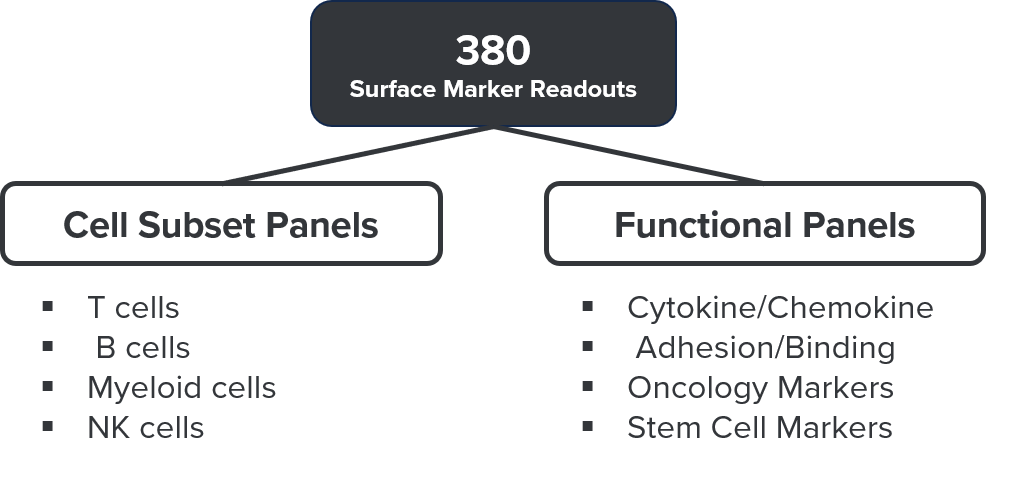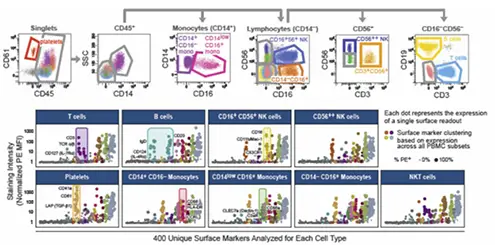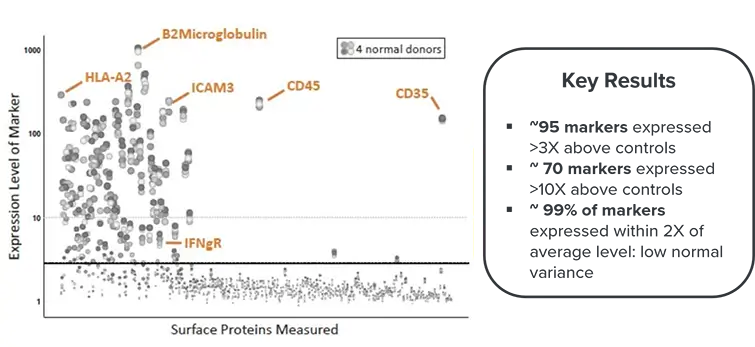Discover Hundreds of Cell Surface Markers with Our Advanced Profiling Service
Discover Cell Expression Patterns with Surface Profiling Platform
By combining the industry’s largest panel of cell surface markers with high-level multi-parameter staining panels, a new ability is created that can-
- define novel cell types
- gain unprecedented insight into cellular differentiation
- and identify potential disease biomarkers.
Our surface profiling platform will allow you to analyze multiple cell subsets simultaneously to generate 1000’s of data points per sample and identify new biomarkers to monitor drug activity or to stratify clinical patient samples.
Get Comprehensive Surface Analysis with Barcoded Multiplexing
Measure up to 380 cell surface markers by flow cytometry using our barcoding system.
Barcoding enables efficient use of small precious samples through multiplexing and may provide cost savings through reduced consumption of reagents.
Our combination of functional and cell subset categories allows for a customized and efficient phenotypic screening of various clinical samples.
By preselecting or customizing panels, identify cell subsets of interest and measure the expression level of proteins on their surface.
This surface profiling is achieved from as few as 1 million cells and is highly reproducible, owing to our use of automated sample processing.

Sample Types:
We work with all types of samples (live, frozen, or fixed) and offer in-house sample procurement, preparation, stimulation, or stabilization if needed.
- PBMC (fresh or cryopreserved)
- Bone Marrow aspirate
- Whole blood
- Stem cells
- Dissociated Tumors/Tissue
- In vitro expanded primary cells
- Suspension or adherent cell lines
Resolve Cell Populations within Heterogeneous Samples Effortlessly
In the example below, cryopreserved human PBMC were stained with a “backbone” marker panel to identify 13 cell populations simultaneously within each sample.
Shown is the expression level of the 380 surface markers in the Surface Profiling service across 9 of the cell subsets. Colored areas represent sets of markers uniquely expressed on one cell subset.
Conserved markers are shown on the right side of the plots.

Enabling Biomarker Discovery
By evaluating expression levels of 380 cell surface proteins, the Surface Profiling platform creates a high-resolution map of the cell surface for each cell population of interest (e.g. B cells, T cells, monocytes, cancer cells).
Compare surface profiles across cell types or between samples to identify biomarkers of cell differentiation, disease progression, or therapeutic response.
To understand how cells from disease samples differ from healthy samples, one first has to define what “normal” is.
Using the Surface Profiling platform, CellCarta is building an industry-leading database of surface protein expression on normal blood and PBMC samples, against which disease samples can be compared.
In the graph below, we applied Surface Profiling to measure 380 surface proteins across 4 normal human donor PBMC samples. Shown is the expression profile of B cells, identified by CD19 expression.

Achieving Deep Insights with Reproducible Surface Profiling Data
CellCarta’s technology platforms take advantage of proprietary sample processing techniques that are designed to
- increase sample handling reproducibility
- accelerate data acquisition
- and optimize cell recovery.
Miniaturization and automation of sample processing and staining enable the delivery of high-content data in a fraction of the time and cost of traditional systems.
Single-cell resolution provides superior insight into each cell surface readout by enabling measurement of per-cell expression levels as well as the proportion of cells in each cell subset expressing each protein.
Extending Beyond Immunophenotyping with Surface Profiling Platform
By analyzing hundreds of receptors, adhesion molecules, and other functional proteins, the Surface Profiling platform provides-
- deeper insight into cell lineage
- differentiation and activation states
- responsiveness to external stimuli, and more.
Readouts include proteins involved in immunity, cancer, and stem cell biology.